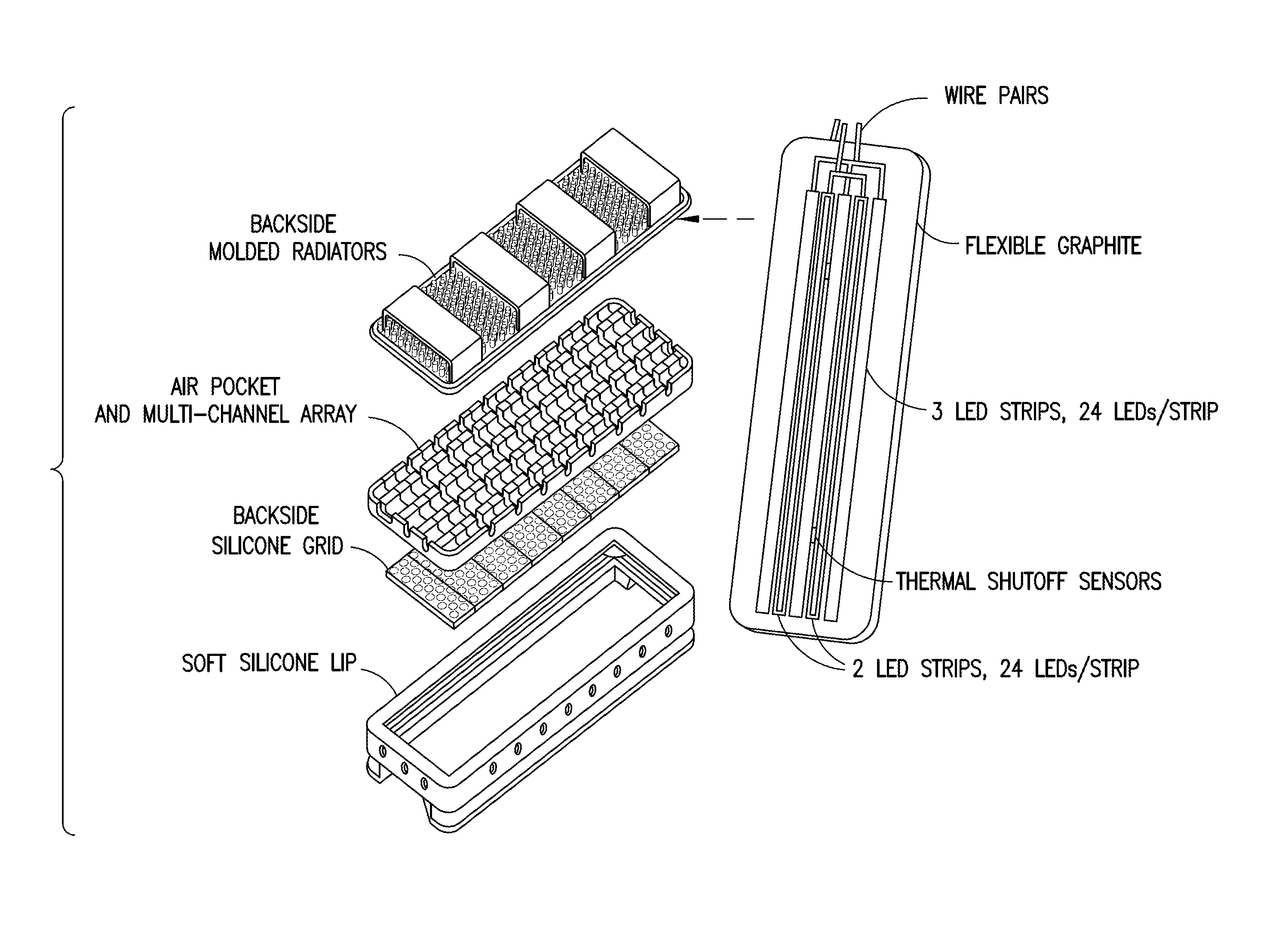Multispectral therapeutic light source
a multi-spectral, light source technology, applied in radiation therapy, medical science, therapy, etc., can solve the problems of high cost, high cost, complicated manufacturing, etc., to reduce surface heating, improve quantum efficiency and cost-effectiveness, and efficiently provide output photon flux
- Summary
- Abstract
- Description
- Claims
- Application Information
AI Technical Summary
Benefits of technology
Problems solved by technology
Method used
Image
Examples
embodiment 1
[0151]Referring now to specific Embodiment 1, there is provided a light source, comprising an array of two or more LEDs and / or OLS, where at least one of the LEDs and / or OLS has one or more materials containing photoluminescent phosphor(s), dye(s), and / or OCSTs that spectrum-shift most of the light energy emitted from the selected LEDs and / or OLS into an emission spectrum substantially within the ONIR wavelength range. Different spectrum-converting materials may be mixed or sequentially placed in the light path so that 1, 2, or more different spectrum converters are present in the light path of at least half the collective initial LED light output.
[0152]Still referring to Embodiment 1, the spectrum converter can be a phosphor or quantum dots mixed into clear silicone or other matrix material placed in the proximity of, or touching the LED light-output surface at a concentration, thickness, and area that can convert 50% or more of initial LED light into broad spectrum ONIR light with...
embodiment 2
[0155]A specific example, designated as Embodiment 2, has an additional light conversion material placed in all or part of the light path, consisting of one or more over 60% quantum yield dyes in an inorganic or polymer matrix such as polycarbonate, impact resistant acrylic, or PVC. Polymer matrix mixtures are anticipated and can be beneficial. For most preferred embodiments 0.05-5 mm would an optimal range.
[0156]Selected perylene derivative dyes have much higher photostability, higher QY, and ease of integration into a wide range of light converters than almost any other red or near-IR spectral range organic dyes. Even though photostability is lower than phosphors, this can be managed in many medical applications for the life of many products or the conversion material can be changed out as part of routine maintenance. The absorption and emission characteristics are needed for useful ONIR spectrum.
[0157]The present invention incorporates inclusion of two new perylene derivative pho...
embodiment 3
[0162]the spectrum converter is comprised of a light source consisting of an array of two or more LEDs with principal light output in the 390-490 nm range, where at least one of these LEDs is covered by one or more layers closest to the LED containing photoluminescent phosphor(s) and / or quantum dots so that over 50% of the output light spectrum from the converted LED(s) is within the ONIR spectral range. Additional spectrum-converting layer(s) using fluorescent dye(s) or quantum dots then converts most of the of the light energy exiting the first layer(s) into the ONIR spectral range, and / or into a longer wavelength portion of the ONIR spectral range. This device's output light from the spectrum converter(s) may intentionally contain up to 40% light in the violet and / or blue spectral range with >60% light in the ONIR spectral range. Light source designs with over 99% of the photons in the ONIR range are achievable with this structure and appropriate photoluminescent material concent...
PUM
 Login to View More
Login to View More Abstract
Description
Claims
Application Information
 Login to View More
Login to View More - R&D
- Intellectual Property
- Life Sciences
- Materials
- Tech Scout
- Unparalleled Data Quality
- Higher Quality Content
- 60% Fewer Hallucinations
Browse by: Latest US Patents, China's latest patents, Technical Efficacy Thesaurus, Application Domain, Technology Topic, Popular Technical Reports.
© 2025 PatSnap. All rights reserved.Legal|Privacy policy|Modern Slavery Act Transparency Statement|Sitemap|About US| Contact US: help@patsnap.com



